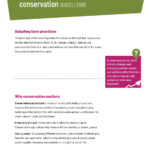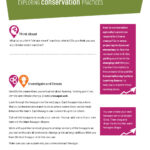Which practices do farmers in Alberta use more than farmers in other provinces in Canada?

 Explore examples of conservation agriculture practices used to help protect the land from climate and weather events, such as droughts, heavy precipitation, high winds, wildfire and extreme temperatures in CONSERVATION AGRICULTURE.
Explore examples of conservation agriculture practices used to help protect the land from climate and weather events, such as droughts, heavy precipitation, high winds, wildfire and extreme temperatures in CONSERVATION AGRICULTURE.
In EXPLORING CONSERVATION PRACTICES, create a hexagon web to make connections between concepts related to conservation farming practices, climate and climate change. Consider how conservation agriculture applies to the United Nation Sustainable Development Goal on Climate Action and rank options for your own personal action.
changing farming practices
Farming is the practice of growing plants and raising animals for food. In the past, most farms were small, and farm families practiced mixed farming. For example, farmers may have grown wheat and barley and have a dairy cow, chickens and pigs on their farms.
Although this has changed, the family farm has not. Over 97 percent of Canadian farms are family farms.
Farms today rely on scientific research and developments to grow crops and raise animals, while at the same time responding to challenges like those that result from climate change.
According to the Government of Canada and the Census of Agriculture, farmers are using practices that make farming more sustainable and resilient to changing weather patterns.
- As of 2021, more than 50 percent of farms in Canada, including those in Alberta, used zero-till or reduced-till farming methods. This helps prevent soil erosion, retain moisture and reduce carbon emissions from soil disturbance.
- Increasing numbers of farmers in Alberta are planting cover crops. In Canada, about 15 percent of farmers have reported using cover crops to improve soil health and manage moisture.
- Alberta farmers are using more drip irrigation systems and other water-saving methods. In 2021, 25 percent of irrigated farms in Alberta had adopted drip or micro-irrigation systems, which are more efficient and reduce water waste.
- Across Canada, the use of solar panels and wind energy on farms has increased by 10 to 15 percent over the past decade. Alberta has seen a rise in solar-powered farms, helping reduce the reliance on fossil fuels.
- Alberta farmers are planting more drought-tolerant crops, like certain varieties of wheat and canola, to adapt to changing rainfall patterns. Crop variety changes have been reported on over 30 percent of farms in drier regions.
dairy farm examples
Think about these examples of the practices used by farmers across Canada.
![]() What practices would you like to know more about? Why?
What practices would you like to know more about? Why?
Erin from Saskatchewan
We were already practicing crop rotation of corn and barley for silage mainly. When we looked at how we could still get a crop in very wet conditions after getting close to four feet of rain in 2010, we considered diversifying our crops. This was successful. Oats are more resistant to heavier rainfall early in the season, and when we added other cover crops in the mix, like fava beans, peas and other legumes, the variety of plants help the soil nutrient levels and offer protein for the cows.
Matt from BC
My takeaway is the less tillage, the better. The less you do with soil the better. We do crop rotations, we plant cover crops and we reduce tillage as much as possible, because the less the land is tilled, the better it is for the soil. We noted that this cuts down on tractor and fuel use, which saves money and emissions too.
We have four fields, two on which grow orchard grass, a perennial, for four years while the other two grow corn. And then we switch them out – that’s crop rotation.
Alain from Quebec
On our farm, we also avoid disrupting the soil. We aim to have prairies that have various forage plants and last many years – five, six years or more. We add legumes to the prairie grasses, like one would overseed a lawn. Overseeding helps regenerate the grasslands and have pastures that offer lots of nutrition to our grass-fed cows. Our approach has always been to go back to basics so we feed our cows with pastures, and harvested forages.
Find out more about the practices used by these farmers on the Dairy Farmers of Canada website.
a pulse advantage
Pulses – the edible dry seeds of legumes – are one example of a crop that supports many conservation practices.
- The growing season for pulse crops is a bit different from that of other crops, in some cases allowing farmers to seed and harvest earlier or later than other crops.
- A four-year crop rotation that includes pulses can reduce disease.
- Pulses can grow in both conventional and zero till systems under irrigation or on dry land.
- Pulses make soil healthier by putting nutrients, including nitrogen, back into the soil.
- Crops like pulses that fix nitrogen can help reduce carbon dioxide emissions from agriculture. Because of their water use efficiency and ability to grow in zero till systems, pulses may have a lower environmental footprint than other crop types.
a net zero barn
Have you heard of net-zero homes or buildings? In southern Alberta, the Brant Hutterite Colony is home to Canada’s first ever net-zero egg barn.
How did they do it? Two innovations are key. First, 100 solar panels line the barn roof and power the equipment inside.
Second, a unique heat recovery ventilator (HRV) — the first of its kind in a Canadian egg barn. The HRV “preheats” the air that is drawn into the barn during winter. This saves energy otherwise spent heating the interior of the barn.
This barn was constructed in 2014. By 2020, the layer barn achieved its electricity net-zero target, meaning that the energy used to power the barn is equal to the amount of renewable energy created on the farm.
![]() In what ways can a net-zero barn help farmers deal with climate challenges?
In what ways can a net-zero barn help farmers deal with climate challenges?






